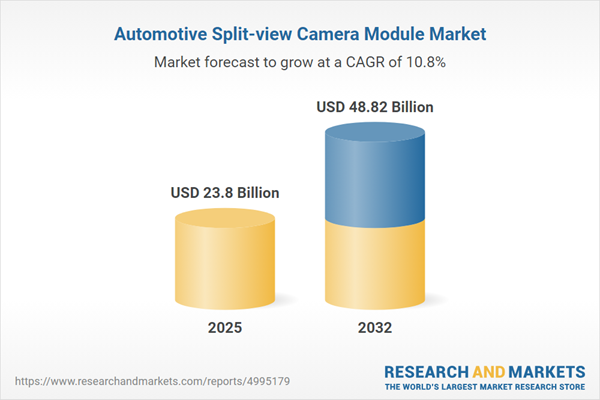Speak directly to the analyst to clarify any post sales queries you may have.
Senior fleet executives in the automotive sector are sharply focused on integrating advanced safety and compliance tools as part of their modernization agendas. Incorporating the latest automotive split-view camera module market solutions equips organizations to address evolving regulatory demands while minimizing operational risks and supporting long-term business resilience.
Market Snapshot: Automotive Split-View Camera Module Market
The automotive split-view camera module market is experiencing sustained global growth, propelled by increasingly stringent safety requirements and regulatory oversight. In 2024, the market reached USD 21.48 billion, with projections indicating expansion to USD 23.80 billion by 2025 and a further rise to USD 48.82 billion by 2032, reflecting a CAGR of 10.80%.
Leading industry players are advancing both product development and manufacturing processes to meet escalating standards. Rapid adoption of new technologies in this space is becoming essential for organizations aiming to maintain business continuity and optimize their fleet operations.Scope & Segmentation
- Applications: Solutions support blind spot detection, night vision enhancement, parking assistance, and comprehensive vehicle monitoring. These functions enhance fleet safety and help reduce incident rates for organizations managing diverse vehicle classes.
- Sales Channels: OEM-supplied modules and aftermarket options are available, offering scalable modernization pathways for both fleet expansion and replacement planning.
- Vehicle Types: Modules accommodate passenger cars, light commercial vehicles, and heavy-duty fleets. This broad compatibility simplifies the adoption of unified safety protocols and streamlines asset oversight.
- Imaging Technologies: Solutions utilize CCD and CMOS sensor technologies, ensuring reliable imaging quality alongside adaptability for varying operational and environmental demands.
- Installation Types: Options include modular assemblies, stand-alone systems, and retrofit solutions, allowing phased upgrades that balance capital planning with compliance objectives.
- Price Points: Procurement teams can choose among entry-level, mid-range, and premium modules. This flexibility enables strategic investment aligned with internal compliance policies and available budgets.
- Regional Coverage: The market spans North America, Latin America, Europe, Middle East & Africa, and Asia Pacific. Distinct supply chain patterns and regulatory influences impact technology adoption and fleet upgrade cycles across these regions.
- Companies Profiled: Major suppliers leading industry innovation and supply chain integration include Robert Bosch GmbH, Continental AG, Aptiv PLC, Denso Corporation, Valeo SA, Hyundai Mobis Co., Ltd., Magna International Inc., Gentex Corporation, Visteon Corporation, and Hella KGaA Hueck & Co.
Key Takeaways for Automotive Split-View Camera Module Market Leaders
- Integrated split-view camera modules help streamline compliance processes, providing organizations with scalable safety solutions across varied fleet compositions.
- Strategic partnerships with supplying firms specializing in components like semiconductors, optics, and embedded software drive efficient deployment and enhance overall system reliability.
- Modular architectures act as an enabler for progressive modernization, supporting organizations' diverse operational priorities and phased implementation approaches.
- Advanced digital integration and high-definition imaging contribute to better real-time awareness for drivers and fleet managers, which can elevate both daily safety and operational performance.
- Capabilities such as remote diagnostics and live software updates support maximized uptime and minimize disruptions, strengthening supplier relationships and ensuring uninterrupted fleet performance.
- Procurement strategies that emphasize compliance and operational stability allow businesses to navigate regulatory transitions or industry fluctuations with fewer interruptions to service.
Tariff Impact on the Automotive Split-View Camera Module Market
Recent changes in U.S. tariffs have directly increased costs for essential electronic components, affecting sensor chips and circuit boards. To mitigate these cost pressures and reduce supply chain risk, many organizations are adopting nearshoring strategies, expanding local assembly operations, and further optimizing supply chains to maintain consistent delivery of split-view camera modules despite shifting trade conditions.
Methodology & Data Sources
This analysis is grounded in executive interviews, a systematic review of technical documentation, and patent and trade filing analysis. Subject-matter experts validate each stage to ensure accuracy and practical relevance for senior decision-makers considering investments in the automotive split-view camera module sector.
Why This Report Matters
- Empowers organizations with actionable insights to shape safety-focused, technology-driven fleet strategies in line with the evolving automotive split-view camera module market.
- Guides procurement and technical teams in developing integration frameworks that enable efficient upgrades across various regional and organizational footprints.
- Offers targeted intelligence for managing regulatory compliance and responding swiftly to market changes.
Conclusion
Automotive fleet leaders who prioritize modular split-view camera solutions and robust sourcing practices are best equipped to manage regulatory shifts and advance business modernization initiatives. Strategic use of these technologies reinforces operational reliability in a complex automotive environment.
Additional Product Information:
- Purchase of this report includes 1 year online access with quarterly updates.
- This report can be updated on request. Please contact our Customer Experience team using the Ask a Question widget on our website.
Table of Contents
3. Executive Summary
4. Market Overview
7. Cumulative Impact of Artificial Intelligence 2025
Companies Mentioned
The companies profiled in this Automotive Split-view Camera Module market report include:- Robert Bosch GmbH
- Continental AG
- Aptiv PLC
- Denso Corporation
- Valeo SA
- Hyundai Mobis Co., Ltd.
- Magna International Inc.
- Gentex Corporation
- Visteon Corporation
- Hella KGaA Hueck & Co.
Table Information
| Report Attribute | Details |
|---|---|
| No. of Pages | 181 |
| Published | October 2025 |
| Forecast Period | 2025 - 2032 |
| Estimated Market Value ( USD | $ 23.8 Billion |
| Forecasted Market Value ( USD | $ 48.82 Billion |
| Compound Annual Growth Rate | 10.8% |
| Regions Covered | Global |
| No. of Companies Mentioned | 11 |









